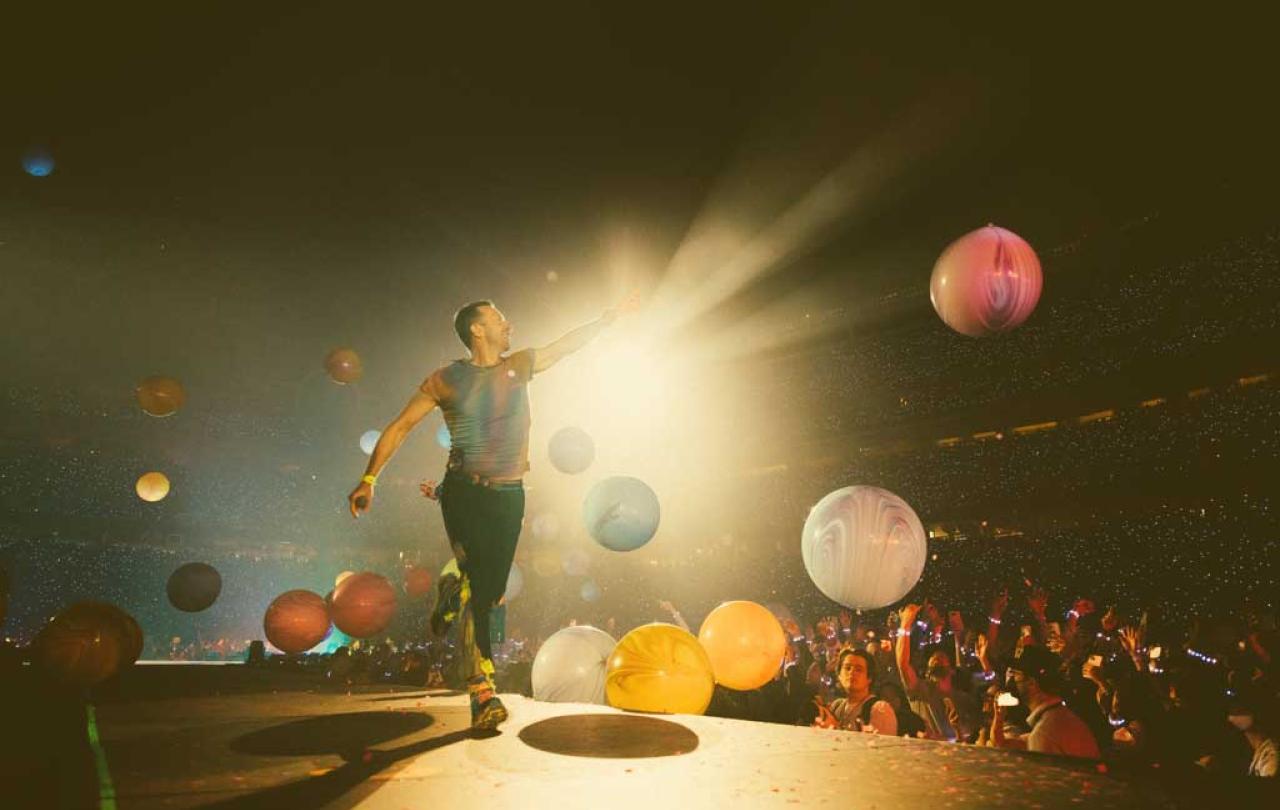
Coldplay are about to wrap up the European leg of their Music of the Spheres tour; their multi year-long and (literally) world-wide spectacle. When I say spectacle, I really mean it. The three-hour long show is nothing short of an audio-visual marvel, one that they’ve played to millions of people over the past year or so, and a couple of weeks ago, I was (rather unexpectedly) one of them.
Hold your personal tastes for a while, leave your ‘Coldplay make me cringe’ critiques at the door (you can pick them back up at the end), and allow me a moment to paint the picture for you.
The band adorn alien masks, they duet with a puppet, they dance upon a stage that changes colour beneath their feet, they release a tidal wave of giant beach balls, they dance through a downpour of confetti, and they bring it to an end under a canopy of fireworks. That’s not to mention their most infamous party-trick, the wristbands that turn the audience themselves into the lightshow. The result is, as you can imagine, utterly breath-taking. The crowd become a panoramic murmuration of colour that dances around the stadium.
Aside from the long queues for the bathroom and the sticky folding seats, the escapism is all-encompassing, it doesn’t falter for a moment. All of it made all the more wholesome for knowing that its being powered (at least in part) by the kinetic dancefloor and the spin bikes towards the back of the stadium.
And I know what you’re thinking, I haven’t even mentioned the music yet.
There is something innate within us that is awoken when we are faced with something great, something that transcends us as an individual, that resides outside of ourselves.
What is there to say? Hearing 90,000 people belt out words as heart-wrenchingly vulnerable and honest as ‘nobody said it was easy, no one ever said it would be this hard’ on a cloudy Wednesday evening was as powerful as you would expect. Strikingly countercultural too, where does all that emotional honesty hide when it is not coaxed out by nights like these? But that’s a question for another article. Watching those same 90,000 people put their arms around the ones they love as they sing the words of the cosmically-minded love song Yellow, and then in the next moment dance with abandon to Adventure of a Lifetime was a joy to behold, a people-watcher’s paradise, a true case study in human nature and emotion.
And that leads me to the premise of this piece, which is not wholly to gush over Coldplay.
As I observed these 90,000 strangers, many of whom had travelled a considerable distance to commune together in this place at this time, I was reminded that humans are made with an inherent need for awe and wonder. There is something innate within us that is awoken when we are faced with something great, something that transcends us as an individual, that resides outside of ourselves – and that is exactly what I witnessed. More interesting than any firework display was the sight of 90,000 people who had pressed pause on the daily rhythms of their lives and gone on a pilgrimage in search of awe and wonder.
Awe and wonder are admittedly elusive emotions, notoriously hard to define and harder still to analyse. As a result, they have been largely understudied and overlooked. However, the one thing we do know about awe and wonder is that they are among the most precious and powerful emotions a person will experience. Dacher Keltner, a psychologist at the forefront of a surge of research into the complexities of awe, proposes that awe is distinct; it is not interchangeable with joy or fear, ecstasy, or horror. Rather, raw awe is a particular state that comes as a result of experiencing vastness. As Keltner writes,
‘Awe arises in encounters with stimuli that are vast, or beyond one’s current perceptual frame of reference. Vastness can be physical, perceptual, or semantic and requires that extant knowledge structures be accommodated to make sense of what is being perceived.’
In short, awe is an emotional reminder that we are small.
It is perhaps surprising that coming face-to-face with our minute nature equates to mental and spiritual wellbeing. Our individualistic society would have us believe that such a reality should bring forth feelings of desolation or a fear of oblivion, that awe must therefore be a gateway to some kind of existential crisis. But not so. Numerous studies tell us that is simply not the case.
Believe it or not, we humans benefit from coming face-to-face with our smallness. It has recently been suggested that cultivating awe on a regular basis can ease stress, depression, and anxiety. It can improve our sleep, increase our creative capabilities, and even reduce inflammation. It is a core premise that underlies the Twelve Step programme, an acknowledgment that there is something bigger than oneself, and therefore stronger than one’s addiction, continues to aid countless people in their recovery. Referring once again to Keltner, he proposes that when awe is notably absent from a person’s routine, narcissism, materialism, and a deep sense of disconnection from anything that resides outside of themselves become its inevitable substitutes.
And what’s more, we actually enjoy awe. We crave it. We go out of our way to seek it out.
We build telescopes and gaze into space, we flock to areas of outstanding beauty, we take pictures of sunsets, we visit ancient ruins, we study pieces of art, we sing our hearts out in stadiums brimming with complete strangers.
It’s fascinating. The more you allow yourself to dwell on the nature of awe, the more interesting it becomes. How remarkable that even in a society which is largely built upon premises such as Albert Einstein’s - ‘everything that is really great and inspiring is created by the individual’ - we seem to have a biological afront to this, something ingrained that tells us that this is not true.
Of course, I imagine you have been waiting for me to bring God into all of this? To say that any awe the world can offer is but a mere glimpse, to allude to something similar to what C.S Lewis said, that
‘if you find yourself with a desire that no experience in this world can satisfy, then the most probable explanation is that you were made for another world’
and subsequently suggest that the seen cannot compare with the unseen.
I suppose it could absolutely be argued that our craving for bigger things is a symptom of our craving for the bigger thing. That our wonder at all things transcendent is a taste of the wonder on offer from the transcendent. And that is certainly an intriguing thought. That’s the kind of thought that has led the likes of Paul Kingsnorth into Christianity, and David Baddiel to oppose it. Do we crave vastness and need awe because we crave and need God? Or do we crave (or as Baddiel would argue, create) God because we crave vastness and need awe? Such a thought could be pondered for a lifetime, and I suppose now would be as good a time as any to start.
But for now, I shall return to where I started, sitting on seat M22 at a Coldplay concert, just one of a sea of 90,000 people, all listening to a set list of songs that have become cultural artefacts. Each tune that bellowed from Cardiff’s Principality Stadium during Coldplay’s residency there gathered countless individual stories and bound them together into a wonderous collective sound. It both belonged to every person there and transcended them.
If you ever found yourself in need of a lesson in awe, I would heartily recommend.





